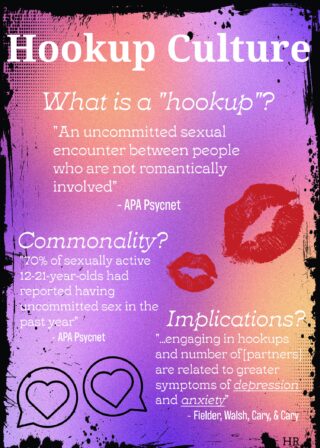Let’s Vote Hookup Culture—and the Media That Glorifies It—Off the Island
By Aarna Mishra, Libertyville High School
Infographic by Hayden Ries, Henderson County High School
There’s a stranger in my bed / There’s a pounding in my head / Glitter all over the room / Pink flamingos in the pool…
Since its release in 2010, Katy Perry’s “Last Friday Night (T.G.I.F)” has been streamed over 1 billion times on Spotify. Whether in the car, at parties or alone in the comfort of one’s room—myself included—this fun, catchy anthem has been a cultural staple. But while Perry succeeds in capturing the thrill of letting loose at the end of the week, each stream contributes to the romanticization of the “hookup” culture, as portrayed in this song.
Casual sexual encounters have existed for generations. As birth control progressed, feelings of attraction without emotional intimacy became more common; however, psychologists like Dr. Mark Travers, who holds degrees from Cornell and the University of Colorado Boulder, have found that hookups can lead to feeling extremely isolated. His research proved that the instant gratification found through these encounters often distracts from seeking real love and—in reality, can leave a deeper feeling of emptiness.

By Hayden Ries, Henderson County High School
The term “hookup” is inherently ambiguous. Debated between friends and dictionaries, everyone seems to have their definition of what qualifies as “hooking up.” This is clearly part of the problem.
“People think that everybody is hooking up because nobody really knows what it means,” Brown University’s Assistant Professor of Education David Rangel said. According to the American Psychological Association, hookups are defined as “brief, uncommitted sexual encounters between people who are not romantic partners or dating each other.” Yet, even with this clear definition, media depiction often encourages viewing casual sex as carefree and consequence-free, emitting the conversations of STDs, accidental pregnancies and damage to mental health.
Even in 2025, we are still publishing and consuming all types of media that—possibly unknowingly—glorify this culture. Shows like “Love Island” have become social phenomena, especially among teens.
My friends and classmates talk about it constantly. The drama, the competition, the flirty challenges—the drama is addicting, especially for high schoolers who thrive on it. While the show technically discourages overt sexual activity, its structure (forcing contestants to pair up and strategize romantic manipulation) effectively gamifies the dynamics of hookup culture.
A large portion of the viewership is teenagers, who are extremely vulnerable to these portrayals. In a time when many are navigating confusion in personal identity, confidence, and connection, Fear of Missing Out (FOMO) can push them towards behaviors they may not have the emotional capacity to handle. Media promotes the idea that “everyone’s doing it,” which can distort the complicated reality.
A study published on APA Psycnet examined the difference between romantic sex between dating partners and casual sex. Only casual sex was linked to higher rates of depression, anxiety, and other mental health struggles.
Unfortunately, it’s not just reality TV. Scripted shows like “Overcompensating” or “The Sex Lives of College Girls” also treat hookups as the default storyline. A similar message is presented in some of today’s scripted shows.
They highlight the excitement associated with these encounters, ignoring mature conversations and parts of the negative aftermath. Even when these storylines are acknowledged, it’s written in the storyline to create drama and conflict. The audience rarely sees the character reflect or learn a lesson.
These shows have also gained audiences for their portrayal of LGBTQ+ relationships—and queer hookups. The romanization of casual sexual encounters bleed into these characters’ lives as well. In a community where representation is limited, this depiction can affect the way young teens see and understand themselves through these characters, further skewing their view and possibly impacting future relationships.
By normalizing hookups and brushing past the real emotional toll, the media often misleads its audience—especially young people—into believing this culture is empowering, fun, and harmless. But real life isn’t written by producers.
Maybe this Friday night, the media should stop glorifying casual sex—and say no to “doing it all again.”
